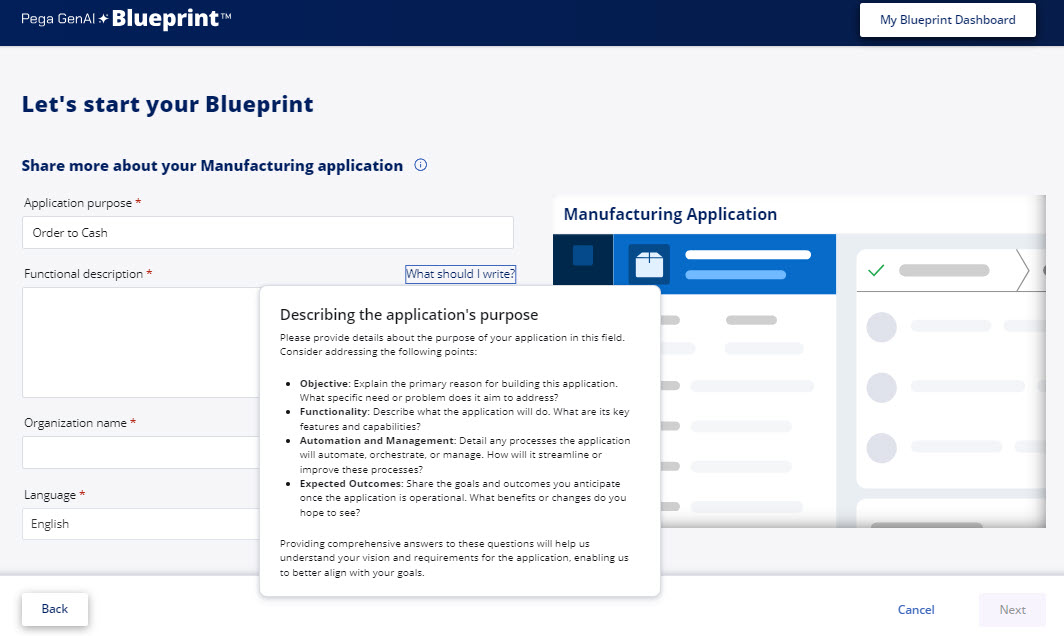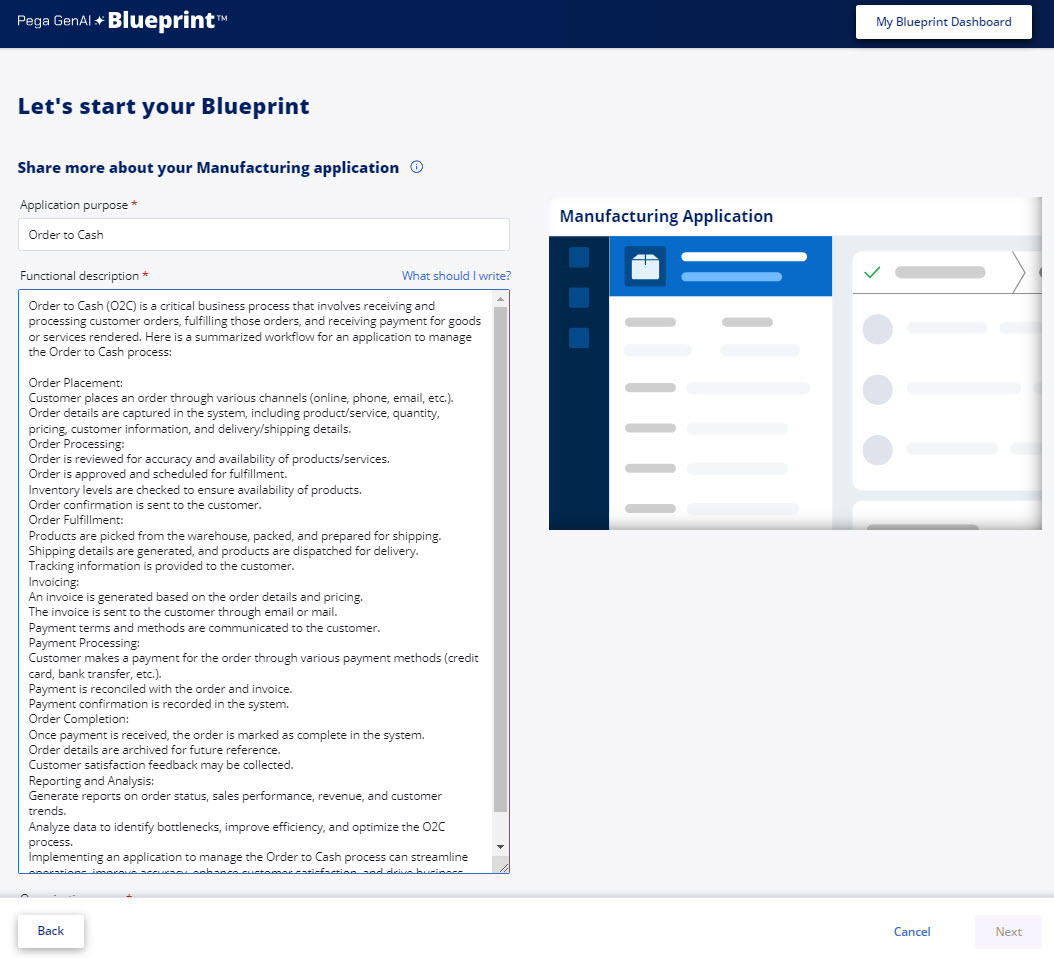Discussion
Pegasystems Inc.
ES
Last activity: 24 Oct 2024 9:13 EDT
Boosting your Blueprint design thinking with prompt engineering tips - More context - less ambiguity
Large language models are unlikely (at least in the near term) to give you an exact and repeatable answer every single time. There's always going to be the possibility they do something a little bit unexpected, and this is by design and can be a really good thing as it empowers creativity.
Taking this in consideration, a lot of what we're going to be doing in Blueprint is trying to deal with the fact that large language models have some unpredictability to them. And we want to sort of constrain that unpredictability, we want to mold it and shape it and work with it in a way that's helpful to us. What I mean by this is that there's always some randomness, some ability to generate new and different ideas each time you put a prompt in. But what these techniques will typically give you is they will give you something that's more reliable that works most of the time or a lot of the time but isn't guaranteed to work every single time.
I would like to share some tips that are working really well for me and should help you to speed up your skills when prompting in Blueprint.
Getting better results by adding more instructions
Incorporating specific and relevant data into your Functional Description significantly enhances the quality of AI-generated assets, providing a solid foundation for the AI to understand the context and craft precise answers. Providing data organized in a clear and structured way, allows for detailed analysis and decision-making. It’s essential to give context to the data.

Here you can see an example for an Order to Cash application. Some general overview of the process is described and the specific workflow tasks. The functional pieces are described individually, providing the context and been as specific as needed to guide the LLM to understand our business requirements.

On submit, you will see the case types proposed: Six case types are suggested following our guidelines.

Specify your desired output
Provide instructions on what to do instead of what not to do. When constructing prompts for AI, it’s more effective to direct the system toward the desired action rather than detailing what it should avoid. This positive instruction approach reduces ambiguity and focuses the AI’s processing power on generating constructive outcomes.
Keep in mind prompt engineering is not a one-off, and in Blueprint this technic is used widely.
Regenerate the component if you think it doesn’t fit your business requirement.
You can do this in several places like clicking on the 3 dots in the Case Type landing page or once in Case Lifecycles definition.

Split complex tasks into simpler ones
When dealing with complex processes, breaking them into simpler, more manageable components can make them more approachable for an LLM. Using step by step instructions helps prevent the AI from becoming overwhelmed and ensures that each part of the task is handled with attention to detail. Again, regeneration is a tool that can be used endlessly until you match your business requirements. Here are some examples of how complex tasks can be split into simpler ones within the Financial Services and Insurance sectors:
Policy Underwriting
Complex Task: Underwriting a new insurance policy.
Simplified Steps:
- Collect applicant information and relevant data.
- Evaluate the risk factors associated with the applicant.
- Determine the appropriate coverage and premium rates.
- Generate the policy document and terms.
- Review the policy with the applicant and make necessary adjustments.
- Finalize and issue the policy.
Loan Application Processing
Complex Task: Automating the loan application process
Simplified Steps:
- Collect applicant information and required documents.
- Verify the authenticity of the documents.
- Assess the applicant’s creditworthiness using predefined criteria.
- Calculate the loan amount and interest rate.
- Generate the loan agreement and send it to the applicant for review.
- Finalize the loan approval and disbursement.
These examples illustrate how breaking down complex tasks into smaller, manageable steps can make them more approachable and ensure that each part is handled with attention to detail. This approach is particularly useful when working with large language models (LLMs) to ensure accuracy and efficiency.
Look for semantic meaning in the words you are using
Imagine you are aimed to create an application for Auto claims. But typing only AutoClaims with no context the LLM won’t know if you refer to Auto (Vehicle) claims or any other type of Claims which are auto-resolved. Providing a semantic mean or context to avoid unexpected results.
In summary, these are some tips to be added into your compelling prompts
- Do your best to ensure your app description includes:
- Objective: Clearly state the goal of the business process. For example, “The objective is to streamline the customer onboarding process.
- Desired Improvements: Specify what improvements you are looking for. For instance, “Reduce verification time and improve accuracy.”
- Key processes you know of. Key Steps: Outline the main steps involved in the process. For instance, “The process includes initial contact, document collection, verification, approval, and account setup.
- Business problems you want to solve. Pain Points: Highlight any known issues or bottlenecks. For example, “Document verification is time-consuming and prone to errors.”
- Inputs and Outputs: Specify the inputs required and the expected outputs at each step. For example, “Input: Customer application form; Output: Verified customer details.
- Key personas. Roles and Responsibilities: Identify the roles involved and their responsibilities. For instance, “Sales team collects documents, compliance team verifies them.”
- Key systems & data you know of
- Compliance & standard to adhere to. Dependencies: Mention any dependencies between steps. For example, “Verification must be completed before approval.”
- Be specific around key expectations:
- What workflows do you expect. Tools and Systems: List the tools or systems used in the process. For instance, “CRM software for document collection, verification tool for compliance checks.”
- What personas are mandatory and when.
- Goals & KPI's
With all these considerations, keep improving your Blueprint prompts, asking them to break out things really in a way I'm sure it fits what our business is looking for. I'm rapidly experimenting with my ideas. I'm trying to get my thought form. I'm trying to understand what this would look like, and I can refine it and improve it further,
Comment below with some of your best practices and good Blueprinting!!
